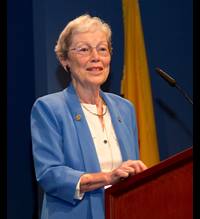Darleane C. Hoffman, Ph.D.

Citation
For scientific discoveries advancing the field of nuclear and radiochemistry, for distinguished service to the Department’s missions in national security and nuclear waste management, and for sustained leadership in radiochemistry research and education.
Laureate video: Darleane C. Hoffman, Ph.D.
Video credit: Lawrence Berkeley National Laboratory.
Biography
Dr. Darleane C. Hoffman's achievements span the disciplines of nuclear chemistry, actinide chemistry, radiochemistry, environmental chemistry, and actinide separation science, bearing witness to a career of remarkable creativity, insight, and lasting impact. Substantiation of both the significance of her accomplishments and their impact on DOE missions can be found in the history of recognition she has achieved in her career, having made enduring impact on DOE missions that encompasses the areas of national security, waste management, and environmental management. This impact stems from her scientific record of accomplishment, her record of excellence in management and leadership, her technical service impacting policy related to radioactive waste management and national security, and her tireless support for education in nuclear and radiochemistry.
Darleane C. Hoffman was born in Terril, Iowa, and completed B.S. and Ph.D. degrees in Chemistry at Iowa State University. There she met and married Marvin M. Hoffman. She joined Los Alamos Scientific Laboratory as a radiochemist in 1953. She conducted groundbreaking studies of the fission properties of fermium-257. She created methods for separating plutonium and the actinides, which became the basis for analyzing nuclear test debris and were used in the national security community for programs in nonproliferation and treaty verification. Her group’s studies of radionuclide migration at the Nevada Test Site helped formulate methods for safe storage of nuclear waste, and its isolation from the environment. Her group was the first to demonstrate the presence of transuranium elements in nature.
In 1984, she became a Professor of Chemistry at the University of California, Berkeley, and Leader of the Heavy Element Nuclear and Radiochemistry Group at Lawrence Berkeley National Laboratory. Her development of “atom-at-a-time” chemistry made possible the study of elements with half-lives of less than one minute. Her group investigated the chemistry of elements 104 (rutherfordium), 105 (dubnium), 106 (seaborgium), 107 (bohrium), and 108 (hassium). She and colleagues confirmed the discovery of element 106, which was named for Nobel Laureate Glenn Seaborg. Hoffman also served as the charter director of Lawrence Livermore National Laboratory’s Seaborg Institute for Transactinium Science.
Hoffman’s awards include (among others): US National Medal of Science, Los Alamos Medal, American Chemical Society’s Priestley Medal, Women in Technology International Hall of Fame, American Chemical Society’s Garvan-Olin Medal, Sigma Xi Proctor Prize for Scientific Achievement, and Membership in the Norwegian Academy of Science and Letters.


